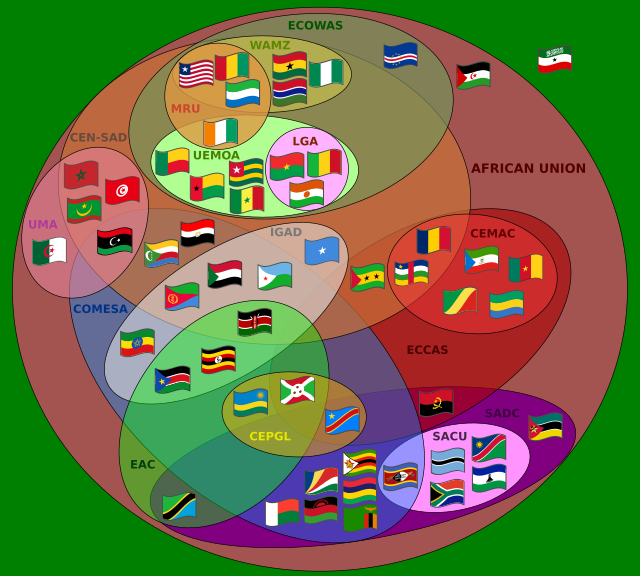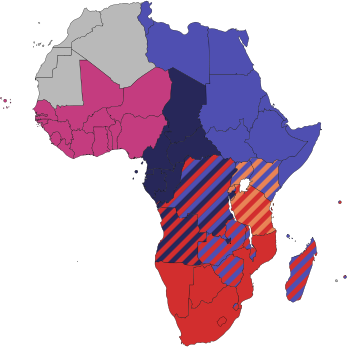African Economic Community International organization
Members of the AEC's parent, the African Union
The African Economic Community (AEC ) is an organization of African Union states establishing grounds for mutual economic development among the majority of African states. The stated goals of the organization include the creation of free trade areas , customs unions , a single market , a central bank , and a common currency (see African Monetary Union ) thus establishing an economic and monetary union .
Pillars
Currently there are multiple regional blocs in Africa, also known as Regional Economic Communities (RECs) , many of which have overlapping memberships. The RECs consist primarily of trade blocs and, in some cases, some political and military cooperation. Most of these RECs form the "pillars" of AEC, many of which also have an overlap in some of their member states. Due to this high proportion of overlap it is likely that some states with several memberships will eventually drop out of one or more RECs. Several of these pillars also contain subgroups with tighter customs and/or monetary unions of their own:
These pillars and their corresponding subgroups are as follows:
Pillar membership
member states; year of joining
member states; year of joining; cooperation in the framework of the bloc stalled
candidate states; year of application
CEN-SAD
Founding states (1998):
Joined later:
COMESA
Founding states (1994):
Joined later:
Former members:
EAC
Founding states (2001):
Joined later:
ECOWAS
Founding states (1975):
Joined later:
Former members:
UEMOA-94:
UEMOA state from 1994
UEMOA-97: UEMOA state from 1997WAMZ state from 2000
WAMZ-10:
WAMZ state from 2010
ECCAS
Founding states (1985):
Joined later:
CEMAC-99: CEMAC state from 1999
IGAD
Founding states (1986):
Joined later:
UMA 1
Founding states (1989):
SADC
Founding states (1980):
Joined later:
SACU-70:
SACU state from 1970
SACU-90:
SACU state from 1990
1 The UMA (Arab Maghreb Union ) does not participate in the AEC so far, because of opposition by Morocco
Overlaps illustrated
The image above contains clickable links Euler diagram showing the relationships among various multinational African entities v t e
REC pillars of the African Economic Community.
Active REC pillars of the African Economic Community.
Other blocs
Other trade blocs in Africa not part of the African Economic Community. Other African regional blocs, not participating in the AEC framework (many of them predating AEC) are:
Their membership is as follows:
GAFTA 1
CEPGL
COI
LGA
MRU
2005 membership:
Joined later:
1976 membership:
1984 membership:
1970 membership:
1973 membership:
Joined later:
1 Only African GAFTA members are listed. GAFTA and MRU are the only blocs not currently stalled.
Goals
The AEC founded through the Abuja Treaty , signed in 1991 and entered into force in 1994
is envisioned to be created in six stages:
(completed in 1999) Creation of regional blocs in regions where such do not yet exist
(completed in 2007) Strengthening of intra-REC integration and inter-REC harmonisation
(completed in 2021) Establishing of a free trade area and customs union in each regional bloc
(to be completed in 2023) Establishing of a continent-wide customs union (and thus also a free trade area)
(to be completed in 2025) Establishing of a continent-wide African Common Market (ACM)
(to be completed in 2028) Establishing of a continent-wide economic and monetary union (and thus also a currency union ) and Parliament End of all transition periods: 2034 at the latest Parts of this article (those related to pre-2017 deadlines) need to be updated . Please help update this article to reflect recent events or newly available information. (January 2017 )
Stages progress
as of September 2007
Stage 1: Completed , only Arab Maghreb Union members and Sahrawi Republic not participating. Somalia is participating, but no practical implementation yet.
Stage 2: Steady progress, nothing factual to check.
Stage 3:
Regional blocs - pillars of the African Economic Community (AEC)
Activity
CEN-SAD
COMESA
EAC
ECCAS
ECOWAS
IGAD
SADC
UMA
CEMAC Common
UEMOA WAMZ Common
SACU Common
Free Trade Area stalled
progressing 1
fully in force
fully in force
proposed for 2007 ?
fully in force
proposed
stalled
fully in force
progressing 2
stalled
Customs Union stalled
proposed for 2008
fully in force
fully in force
proposed for 2011 ?
fully in force
proposed for 2007
stalled
fully in force
proposed for 2010
stalled
1 Members not yet participating: DR Congo (in talks to join), Eritrea , Ethiopia , Seychelles (in talks to join), Swaziland (on derogation until SACU gives permission for Swaziland to join the FTA), Uganda (to join very soon)[1] 2 Members not yet participating: Angola , DR Congo , Seychelles [2]
Stage 4: In March 2018, 49 African countries signed the African Continental Free Trade Agreement paving the way for a continent-wide free trade area . The continental free trade area became operational in July 2019, after 22 ratifications.[ 4] [ 5]
Stage 5: no progress yet
Stage 6: no progress yet
Overall progress
1 not all members participating yet2 telecommunications , transport and energy - proposed3 sensitive goods to be covered from 2012
African Economic Community
Pillar regional
Area(km²)
Population
GDP (PPP) ($US)
Member
(millions)
(per capita)
EAC
5,449,717
343,328,958
737,420
2,149
8
ECOWAS/CEDEAO
5,112,903
349,154,000
1,322,452
3,788
15
IGAD
5,233,604
294,197,387
225,049
1,197
7
AMU/UMA a
6,046,441
106,919,526
1,299,173
12,628
5
ECCAS/CEEAC
6,667,421
218,261,591
175,928
1,451
11
SADC
9,882,959
394,845,175
737,392
3,152
15
COMESA
12,873,957
406,102,471
735,599
1,811
20
CEN-SAD a
14,680,111
29
Total AEC
29,910,442
853,520,010
2,053,706
2,406
54
Other regional
Area(km²)
Population
GDP (PPP) ($US)
Member
(millions)
(per capita)
WAMZ 1
1,602,991
264,456,910
1,551,516
5,867
6
SACU 1
2,693,418
51,055,878
541,433
10,605
5
CEMAC 2
3,020,142
34,970,529
85,136
2,435
6
UEMOA 1
3,505,375
80,865,222
101,640
1,257
8
UMA 2 a
5,782,140
84,185,073
491,276
5,836
5
GAFTA 3 a
5,876,960
1,662,596
6,355
3,822
5
AES 2,780,159
71,374,000
179,347
3
Smallest value among the blocs compared.
Largest value among the blocs compared.
1 : Economic bloc inside a pillar REC.
2 : Proposed for pillar REC, but objecting participation.
3 : Non-African members of GAFTA are excluded from figures.
African Free Trade Zone
The African Free Trade Zone (AFTZ) was announced on Wednesday October 22, 2008 by the heads of Southern African Development Community (SADC), the Common Market for Eastern and Southern Africa (COMESA) and the East African Community (EAC).
In May 2012 the idea was extended to also include ECOWAS, ECCAS and AMU.[ 9]
See also
References
Sources






